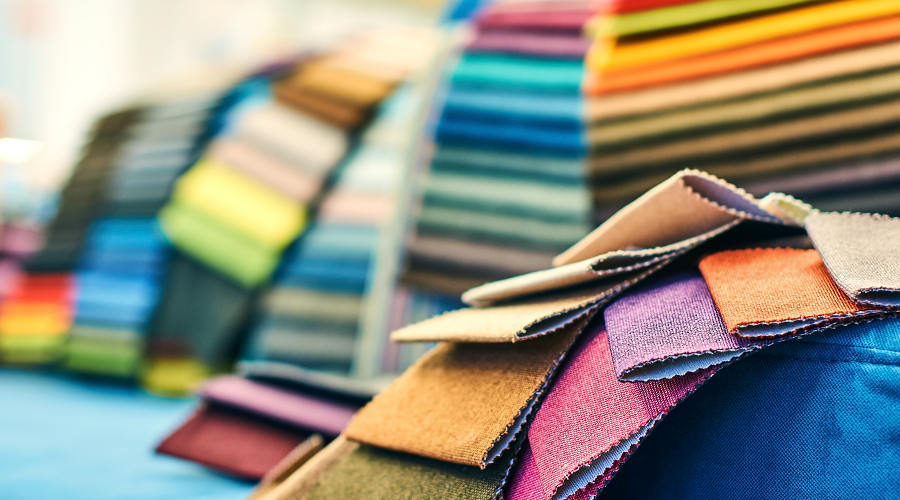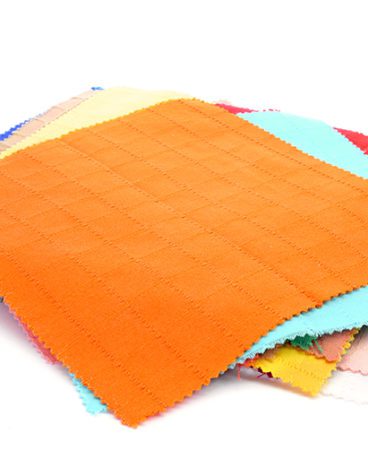Top-of-mind for every textile manufacturer? Speed to market. And the industry shows no signs of slowing down, as major garment producers continue to tighten production cycles by weeks, if not months. When it comes to color, there’s simply no room—or time—for error. Enter Datacolor Match Textile, a sophisticated software solution that formulates color to precise specifications, optimizing color results, streamlining production time, cutting expenses and minimizing environmental impacts.
To formulate a color, Match Textile accounts for all the variables that can influence color—dyestuff compatibility, substrate and process variations, color constancy, metamerism, etc.—to build an optimal color recipe that reduces shade corrections and minimizes overall waste of dye, chemicals and water. What’s more, the software’s automated integration across a full suite of lab and production equipment, including dispensers and dyeing machines, ensures accuracy and consistency in the dyeing process—from concept to fabric.
Uncovering the Myriad Capabilities of Match Textile
Newcomers to the world of color and longtime Match Textile fans alike are probably familiar with only a fraction of the software’s capabilities. That’s why we turned to industry expert Milagros Watts, a Product Manager and 30-year veteran of Datacolor, to decode the layers of functionality Match Textile delivers.
Building a Foundation with SmartMatch
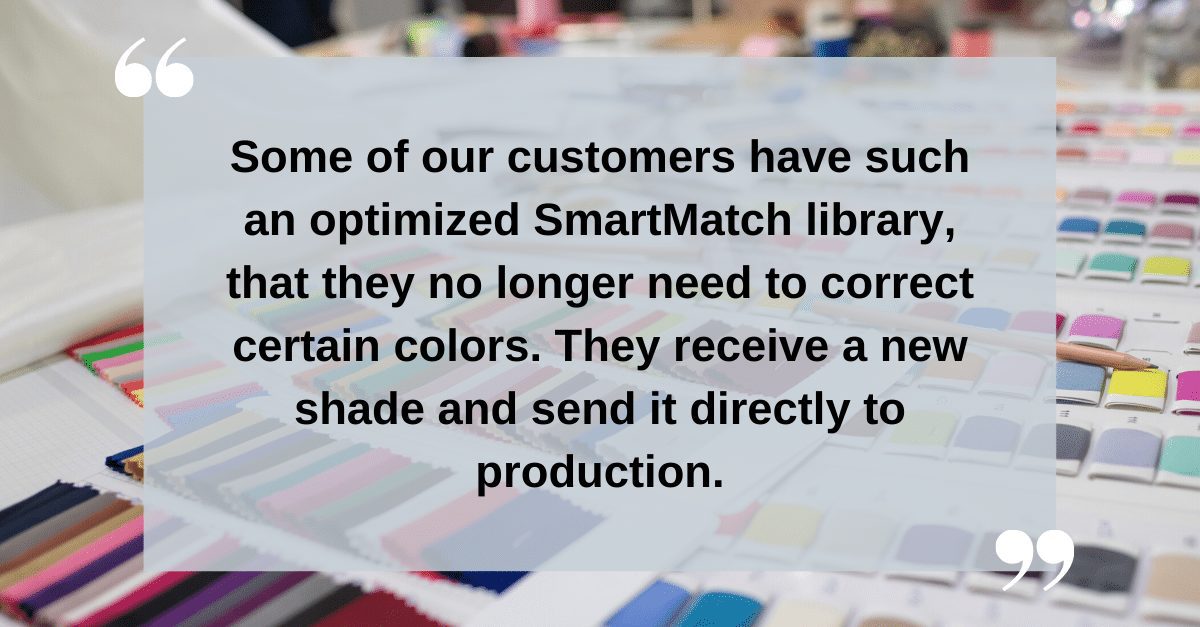
Regardless of the size and scope of a project, every Match Textile user should start to take advantage of our patented SmartMatch technology, says Milagros. SmartMatch identifies systematic discrepancies between recipes that are calculated theoretically and actual dyed recipes and uses algorithms to improve recipe prediction or corrections. The method automatically captures dyeing information from the laboratory or production and groups it into populations that take into account the various parameters affecting the dyeing process, such as the combination of dyestuffs, the substrate, the dyeing process and the equipment used, etc. Then, when a new recipe is formulated, the program retrieves this information and modifies the concentration of dyestuffs based on the SmartMatch populations resulting in a closer prediction than conventional prediction methods.
“Some of our customers have such an optimized SmartMatch library, that they no longer need to correct certain colors,” says Milagros. “They receive a new shade and send it directly to production. This is a testament to the precision of the software—and the faith our customers have in its ability to get color right the first time.”
Mixing the Right Recipe
Thanks to Match Textile’s recipe history, customers who have been working with the software for some time can quickly determine if a new color they receive is already in their library—or if a close enough match exists—greenlighting production much sooner. A searchable database makes it easy to access recipes based on an unlimited number of categories, whether the color was first produced in the laboratory, during a trial or in production.
Moving Beyond the Basics to Advanced Color Matching
Foundational features like SmartMatch and a built-in recipe history are a springboard for the more sophisticated capabilities that can streamline the color selection and production process even further. For example, Match Textile can rank dyestuff combinations to identify which are the most compatible to the substrate or the ones that comply with specific color fastness requirements, thus reducing the need for costly—and wasteful—corrections.
Offset Matching
The intuitive offset matching feature accounts for shade variations that result from post-dyeing or finishing treatments, by assigning an offset value to the initial color formulation. “This, in turn, ensures the right target is formulated every time,” Milagros explains.
The software also can assign a host of custom technical parameters—like quality, dyeset, illuminant, tolerance formula, and general optimization settings—to specific customers, improving the cost and quality of recipes and speeding up color approvals.
Color Constancy, Metamerism and Recipe Optimization
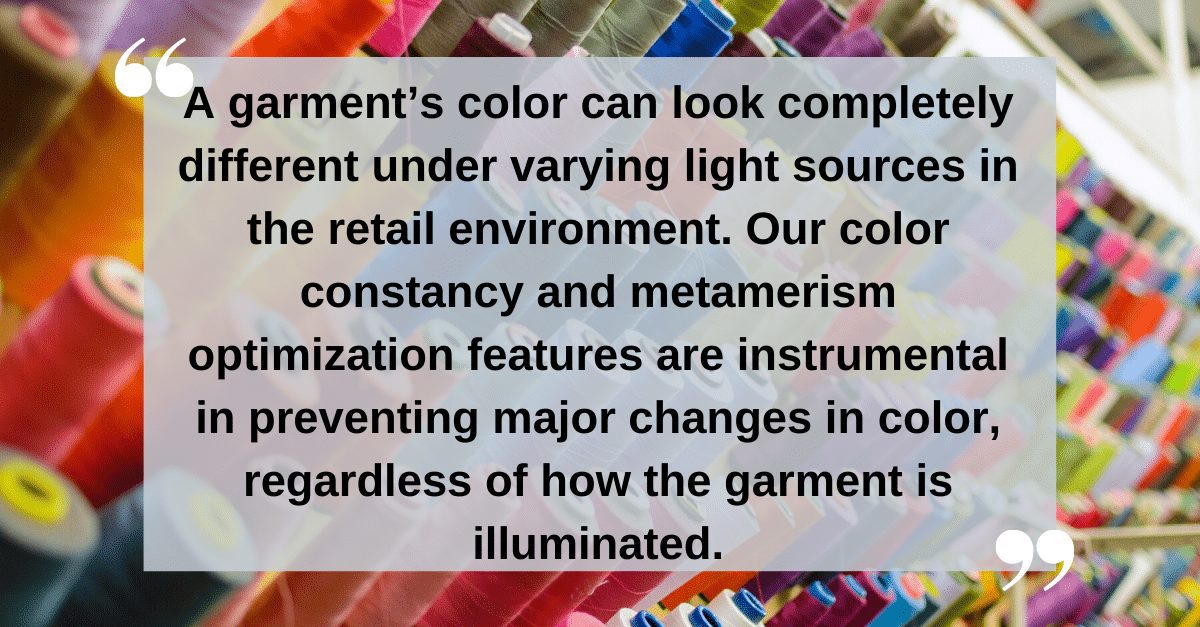
Light is a critical element in color selection. Retailers and color standards providers appreciate Match Textile’s ability to produce feasible recipes for color standards with minimal variation across different illuminants, even under the new LED light sources. “A garment’s color can look completely different under varying light sources in the retail environment,” Milagros says. “Our color constancy and metamerism optimization features are instrumental in preventing major changes in color, regardless of how the garment is illuminated.”
Tying it all Together Across Software and Equipment
Integrating Match Textile with the Datacolor Autolab dispenser and Ahiba dyeing machine brings the software’s color matching capabilities into sharp focus, ensuring consistency of color in a single sample, and ultimately, the final product.
“If you don’t have an accurate method of consistently weighing and dispensing the dyestuffs in the recipe, you will not be able to isolate the causes for errors in the dye preparation process,” says Milagros. “By connecting our software to our dispenser and dyeing machines, we create an automated lab that will give customers an accurate correlation between laboratory and production.”
Furthermore, Match Textile seamlessly integrates with color kitchens and dye machine controllers via Datacolor Process, providing dyehouses complete visibility into color development from beginning to end.
Supporting Speed to Market and Reducing Costs
Extreme time pressure, rising costs, inconsistency across the supply chain and other roadblocks to successful color in the textile industry can grind a production schedule to a screeching halt. Match Textile does the heavy lifting, ensuring accurate color without costly mistakes, to streamline the flow from design to shelf.
“By optimizing recipes, building a library of color recipes, and accounting for variations with SmartMatch, Match Textile brings precision to your color management process,” explains Milagros.
Minimizing Environmental Impacts
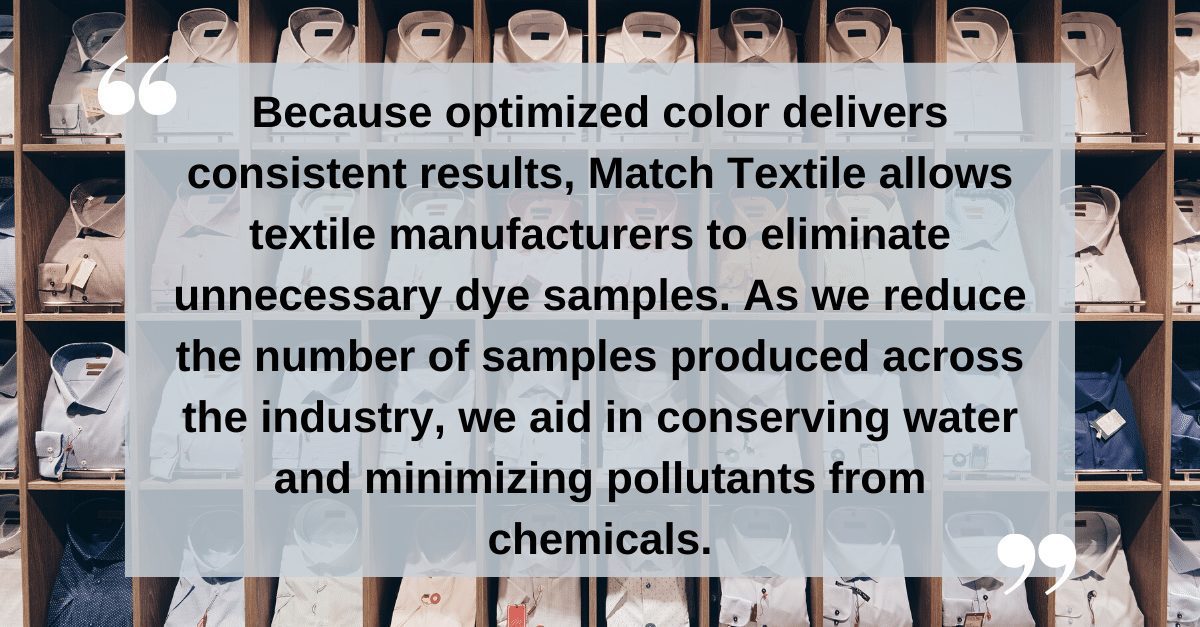
Beyond the cost and time savings afforded by Match Textile, streamlined color means less impact on the environment, specifically water use. The European Parliament notes that the fashion industry is responsible for 20 percent of global clean water pollution. Match Textile delivers optimized color results that eliminate the need to produce multiple dye samples, translating to a reduction in water use and water pollution.
“Because optimized color delivers consistent results, Match Textile allows textile manufacturers to eliminate unnecessary dye samples,” says Milagros. “As we reduce the number of samples produced across the industry, we aid in conserving water and minimizing pollutants from chemicals.”
As the go-to-market calendar continues to shorten, Match Textile is playing an instrumental role in reducing production-stifling color errors, minimizing requests for color formulations that already exist, and eliminating unnecessary and environmentally harmful dye samples—all while ensuring consistent, quality color across the production cycle. Whether you’re considering Match Textile or already a user, our team of experts is here to help you make the most of your software.
